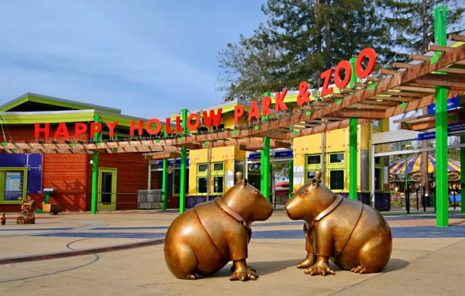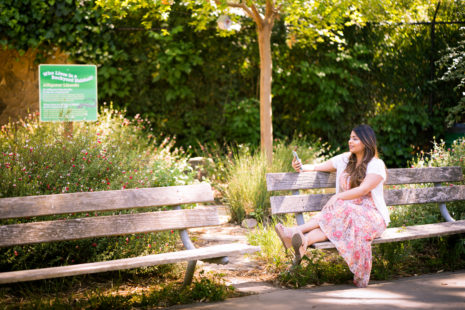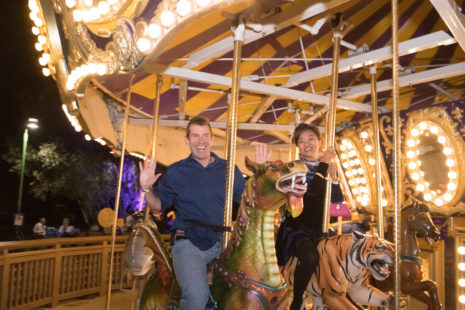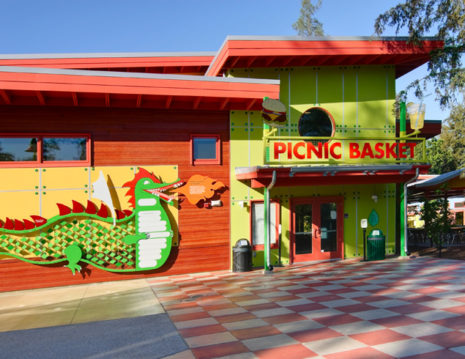
- VisitSupport Happy HollowDONATE TODAYExploreSupport Happy HollowDONATE TODAYLearnSupport Happy HollowDONATE TODAYSupport
-
Today's Hours: 10:00 am to 5:00 pm
Green FacilitiesDanny’s not the only one who’s green at Happy Hollow Park & Zoo.
On July 9, 2008, Happy Hollow closed its gates to begin a $72 million renovation that included 12 acres of existing park and zoo property, as well as four additional acres for new animal exhibits, veterinary and commissary buildings, an education center, a gift shop and a new dining area called the Picnic Basket. The facility was updated to meet ADA standards, and its eco- friendly architecture and other green features earned LEED Gold Certification.
What is LEED?
LEED stands for Leadership in Energy and Environmental Design, and is an internationally recognized green building certification system. LEED ratings provide a third-party verification that a building or community was design and built using strategies aimed at improving energy savings, water efficiency, CO2 emissions reduction and improved indoor environmental quality. Learn more the U.S. Green Building Council.

Recycled Glass
When you enter the Entry Plaza, you're actually walking on broken glass, but don't worry - it won't cut your feet! We salvaged glass bottles and reused them as a decorative element in our Entry Plaza.

The Road from Here to There.
The metal grate you see leading from the Entry Plaza past the Keep-Around-Carousel is an example of how Happy Hollow collects rain. When it rains, the water flows into underground catch basins throughout the Park & Zoo. It then runs under the main pathway known as "The Road from Here to There," where it slowly sinks into the ground. This helps prevent flooding and run-off.

Bioswale
This spiral lawn is more than just a fun pathway - it's a funnel that helps prevent flooding! This drainage course has gently sloped sides, is filled with layers of rock and soil, and is topped with lush green grass. The Happy Hollow bioswale filters rainwater, cleaning it before it reenters the groundwater supply.

Recycled water
When you wash your hands at Happy Hollow, the water doesn't just go down the drain. It gets treated and used again to water plants or flush toilets. When water is reused, it's called recycled water. It's a smart way to treat a previous resource. Happy Hollow also uses low flow toilets, which reduce water usage.

Hay buildings
The walls of the Learning Lodge classroom are made of hay bales stacked on top of each other like giant bricks. There are many advantages to this construction, including low costs, excellent insulation and reducing energy usage.

Habitats and food
Happy Hollow is home to many plants that provide habitat and food for our zoo animals and local wildlife. This promotes biodiversity and drought tolerant plants help reduce water usage.

Danny the Dragon
In 2010, the Danny the Dragon ride got greener with a complete overhaul that converted the engine from gas to a battery powered.

Keep-Around-Carousel
The new Keep-Around-Carousel provides more of Happy Hollow’s trademark whimsy, featuring endangered – or in the case of a certain dragon, imaginary – animals.

Green Roofs
Seven of our buildings also have plants growing on their roofs. These are called green roofs, and they keep the buildings cooler in the summer and warmer in the winter by reflecting sunlight and absorbing less heat. They also reduce storm water runoff and provide additional habitat for local wildlife, including many species of pollinators.

Radiant flooring
Some of Happy Hollow's buildings are heated and cooled by pumping hot or cold water through pipes in the floors. This system is called radiant flooring.
SUPPORT
Happy Hollow isn’t just a place for families with small children. It’s a place where families and friends of all ages can connect without electronic distractions – in fresh air no less! Make a contribution to the Happy Hollow Foundation and support the work of Happy Hollow Park & Zoo.
Donate